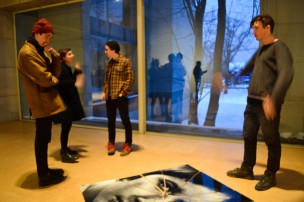Jeffrey Schiff and Sasha Rudensky curated a gallery exploring dimension.
There are more than a few differences between photography and sculpture: for one, they live in different dimensions. As photography becomes more ubiquitous by the day and sculpture remains largely specialized, it takes great creativity to combine these two mediums in a meaningful way. On Thursday, Jan. 29, the Zilkha Gallery demonstrated the extent of this creativity by opening possibly its most unconventional exhibition to date. The exhibition, titled “Picture/Thing,” explores a merging of photography and sculpture that creates unique “cognition experiences” for the viewers.
The exhibition is curated by Art Studio Professor Jeffrey Schiff and Assistant Studio Art Professor Sasha Rudensky, who teach sculpture and photography, respectively, at the University. The inspiration for the exhibition came to Schiff from his own work, where he found photography intersecting with his sculptural work.
“There always seems to be a great connection between the two because photography and sculpture contend with the thing and the space so differently,” Schiff said.
Unlike Schiff’s modernist focus on the natures of the two media, Rudensky’s interest lies in the general anxiety emerging among photographers towards the form’s increasingly commercialized use.
“I start my classes by saying, ‘You have to get over how easy it is to take a photograph,’” Rudensky said. “One of the things that happens with digitization is that photography has been made that much more easy, that much more available—and in some ways—that much more meaningless. So what does it mean to step back, to really think about the process?”
Though this close attention to the mediums’ identities and use in society was the starting point for Schiff and Rudensky, the exhibition ultimately became an inquiry into the new viewing perspectives that are created when the two media collide.
Open until Mar. 1, “Picture/Thing” features 10 artists working with very different styles and themes, some perhaps more accessible than others. Artist Erin Shirreff’s “Monograph (no.4)” addresses the theme of intersection quite directly. Shirreff took photographs of maquette—scale models—she created and then bent the photographs to mimic the shapes of the original pieces, turning the photographs into a different form of sculpture as well. The result is an idiosyncratic study that forces viewers to constantly shift back and forth between seeing a photograph and its subjects.
Rachel Harrison’s “AA” requires a little more explaining. The piece is composed of 13 items, not all closely related. Its focus is a video projected onto a gigantic orange shirt wrapped over a large piece of wood. The video intercuts between a county fair and its sheep. Next to the video sits an A/V cart with the projector and half a dozen other items on it, including hair rollers, a pack of gum, and ear plugs. A yellow extension cord hangs from the ceiling and divides the composition in half. The piece’s yellow and orange overtones coupled with the odd animal sounds from the video contributes to its dream-like, minimalist effect. Harrison will provide further insight into her work during her talk on campus on Wed., Feb. 11.
Artists Jon Kessler and Kendall Baker also visited the gallery on Thursday to talk about their works. Kessler expressed his interest in incorporating video cameras in his pieces. His “Swan” series is a commentary on both the artificial transformations of female faces and what he called “the continuation of cut-and-paste collage that is the go-to process of the 20th century.” The series, made by pasting pictures of female faces on to distorted aluminum, also involves viewer participation by live-recording visitors standing in front of the pieces. As a result, viewers become a part of the distorted faces and engage with the piece’s concepts, whether they like it or not.
“Since I started using the surveillance cameras, I started coupling the pieces with what I call ‘spectacle events,’” Kessler said. “It’s very much weaved into our lives now. We frame the world, and that frame is tightly controlled by the way films are made, the way motions happen.”
Kessler’s “Welcome to Terrordome,” composed of a camera repeatedly filming the same artificial scene made by pictures, best reflects his interest in artificial framing and limited perspective.
Baker developed his “Leavings” series from a string of complex ideas and explorations that involved climbing onto billboards. Inspired by the highway signs he frequently came across during his travels, Baker became interested in how billboards fit into the places they are situated.
“There was this disconnection between the image and this place, and that is something that my photography couldn’t actually, successfully capture in a way that I wanted it to,” Baker said.
Lacking much success atop the billboard, Baker spent more time on the bottom and was drawn to the grass under the billboards.
“[I became] aware of this place, the grass growing down there, the landfills, and how this image up above, these beautiful, shiny, brand-new objects of desire were fitting in,” Baker said. “That contrast, the tension became a point of investigation that I wanted to dig [into] further.”
Baker created the “Leavings” series by pasting blown-up pictures of grass on aluminum, and positioned the parts in specific ways as if they are sculptures. In doing so, Baker makes evident to the viewers the contradiction of the grass’s invisibility and ubiquity, and a camera’s ability to make it visible and unique.
The exhibition not only presented a fascinating concept, but in their various techniques and executions, the “Picture/Thing” artists expanded on the original point of investigation and developed new themes about art, culture, and, as they described it, the “thingness of things.”

Comments are closed